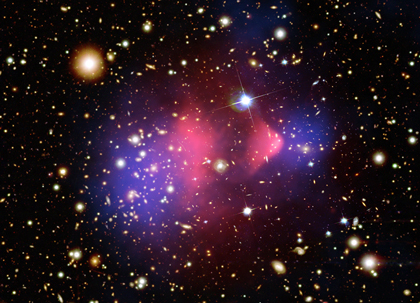
It is early days yet, but astrophysicists and high energy physicists are starting to get a little nervous. We know from astrophysical and cosmological observations that much of the matter in the universe is invisible to us. Indeed, the bullet cluster—a must to mention in every article written about dark matter—provides spectacular supporting evidence for dark matter. But these observations don't do a lot to pin down the properties of dark matter, other than that it is... dark: it doesn't play with electromagnetic forces (light and charge) very often.
This was all fine before the Large Hadron Collider switched on. The LHC was expected to turn up a slew of new particles—particles required to complete the standard model of physics—some of which might have the right properties to be dark matter. Unfortunately, these particles are yet to appear. They could still appear, rising out of the muddy data like a hungry crocodile. Until then, however, astrophysicists have to use the rest of the Universe as their observatory to pin down dark matter. Neutron stars provide a perfect natural experiment, because, their failure to collapse into black holes tells us a lot about how fast dark matter aggregates.
Although this sounds like something very complicated, it is nothing more than measuring friction. Consider a pendulum: it swings back and forth through its rest position. As time goes on, the oscillations get smaller and smaller, until, finally, it comes to rest again. But, if there was no friction—friction in the joint of the swing, or drag from the air about the arm and mass, etc—then it would swing forever.
This same physics applies to matter in the vicinity of stars. The Earth is in a stable orbit about the sun because the constant acceleration due to gravity is much greater than the frictional slowing that it experiences as it passes through the dilute wind of charged particles that permeate space around a star. But, this is not always the case. A perfect example of this are low Earth orbit satellites. The thin atmosphere of the Earth provides sufficient drag that, eventually, the satellite spirals in and burns up in the Earth's atmosphere.
Moving back to dark matter and neutron stars. A neutron star moves through a galaxy that has a thin, relatively uniform halo of dark matter scattered through it. The massive gravitational field of the neutron star sets the dark matter into motion. Much of the dark matter simply escapes, but some ends up orbiting the neutron star—it should be noted that this probably includes orbital paths that pass through the star. Over time, the density of the dark matter orbiting a neutron star should increase. And, if that dark matter eventually spirals in, the mass and gravitational field will increase until a black holes forms.
Chris Kouvaris, from Denmark, wanted to see if this told us anything about how dark matter interacts with itself. But, to be consistent with everything else we know about dark matter, these collision have to be of a rather special nature. The chance of mutual annihilation must be very small compared to collisions that simply change the speed and direction of the particles (including those that release some energy as light, slowing both particles).
We already know from galactic, and larger, scale measurements that dark matter doesn't play with ordinary matter. These measurements also limit how often dark matter particles collide off each other. But these are all low-density situations, and, if dark matter is restricted to short-range exchange of forces—like the attractive forces that hold the atomic nucleus together—then this would be basically unnoticeable. In other words, the strength of the collisions could be quite strong, but so rare that they just don't matter. In a neutron star environment, what was rare in ordinary space, may become a lot more frequent, so they allow us to test whether collisions between dark matter particles are strong enough to slow them down and allow them to accumulate at the center of a neutron star.
The answer: dark matter doesn't accumulate very fast at all. More specifically, Kouvaris used the expected dark matter density to calculate the possible rates of dark matter accumulation. This accumulation rate depends on the details of the model, so the result is a range of dark matter particle masses, force carrier masses, and collisional frequencies that would result in nearby neutron stars to have collapsed into black holes already. This, along with cosmological observations, and, yes, the bullet cluster observations, result in an exclusion region, for which we can say "dark matter cannot be here."
Although Kouvaris' calculations don't exclude vast swathes of dark matter possibilities, every little bit helps. What I like is that it is an elegant bit of work that combines hard experimental data with speculative models that also give us hints about what to look for if we want to narrow the search for dark matter even further.
Physical Review Letters, 2012, DOI: 10.1103/PhysRevLett.108.191301
reader comments
43